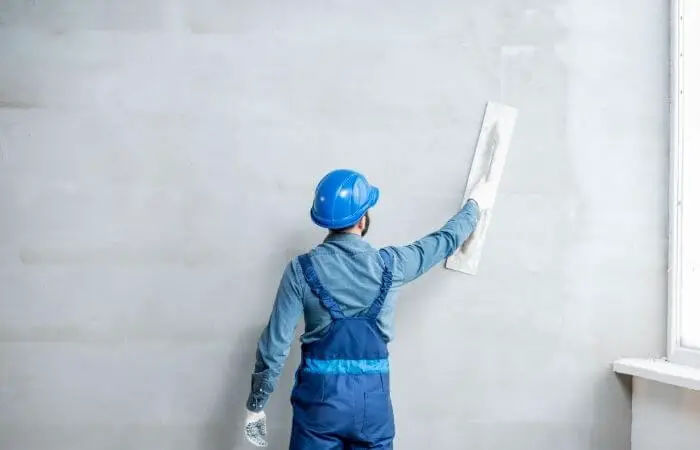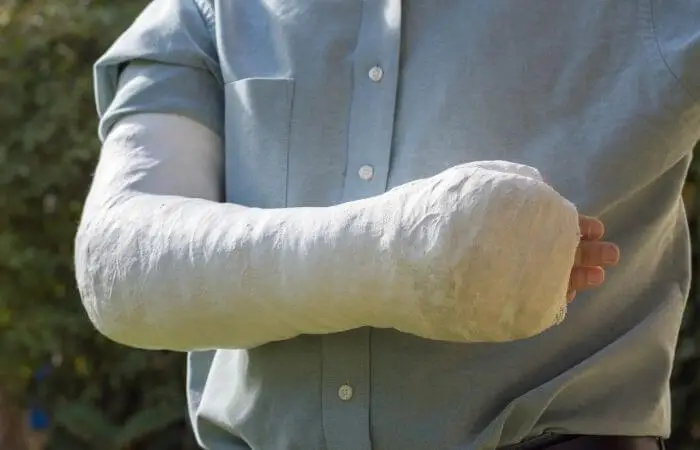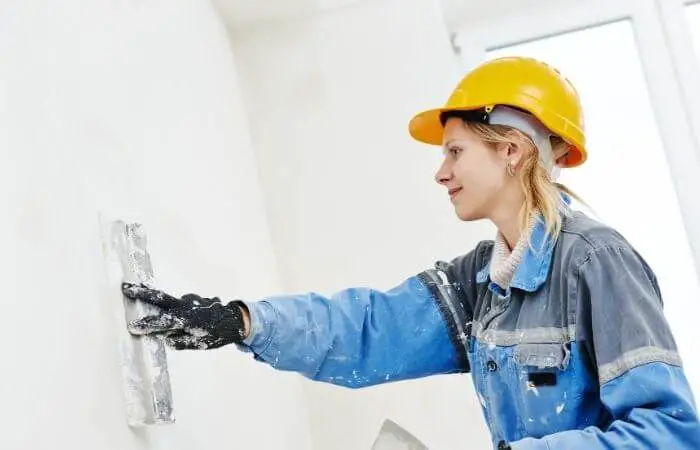Plaster has varying types of water resistance, but there are no commonly-used plasters that are 100% waterproof.
Plaster is made of lime or gypsum and maybe some sand.

If you add water, you can create a hard type of plaster that is used for various building purposes, decorative purposes, and for practical purposes like fireproofing.
Different Types of Plaster
Various types of plaster have differing levels of water resistance (note: being water-resistant is quite different from being fully waterproof).
For example, some types of plaster may absorb water very quickly, and others may withstand a few splashes before any meaningful amount of water is absorbed.
Here are some of the most common types of plaster:
- Clay plaster
- Heat resistant plaster
- Gypsum plaster
- Cement plaster
- Lime plaster
Also read:
Is cement waterproof?
Is MDF Waterproof?
How To Waterproof Plywood
Is OSB Waterproof?
A plaster’s ability to resist water will also depend upon the way the plaster is made and set.
For example, if you were to mix and aerate a batch of under-watered powder, and then let it set/cure, then that batch of plaster will be less water-resistant than if you use the right amount of plaster and you stir carefully rather than mix and aerate.
Also, you may think that if you were to perhaps mix the plaster with added water so that the mixture is sloppy, then you could pour the plaster and have it come out less porous.
And, where that is true, the structure of the plaster would be so weak that it would still absorb water very quickly, and become even weaker when it is wet.
Plaster Of Paris
The most common plaster you are likely to come across and use is Plaster of Paris, which is a quick-setting gypsum plaster that starts out as a dry white powder made of calcium sulfate hemihydrate.
When it is wet it is a pourable fluid and it then dries into a hard porous material.
It has a crushing strength of 2600 psi and is often used in the buildings industry for wall surfacing, sculptures, casts, mold making, the creation of ornaments, and for fireproofing.
Despite being used in the buildings industry, this material is not water-resistant.
You can make it a little more water-resistant with paints and sealants, and even with chemical treatments and the addition of other materials.
However, the structure of the plaster is so porous that even small amounts of water will be absorbed.

Plaster of Paris is also used in medicine to create casts to help broken and reset bones to heal.
Body casts are made from wrapping the limb with bandages dipped in the plaster.
Read our article on how to make your cast waterproof for swimming for more information on plaster of Paris casts.
Which Plasters Are Waterproof?
No type of plaster is waterproof.
As mentioned in the previous section, you can add chemicals, other materials and paints to make it more water-resistant, but you cannot make it waterproof.
In short, if you force water under pressure on the plaster, then water will find its way through.
If you submerge the plaster, then it will become completely soaked.
And, if you drip water on the top of the plaster, then the water will eventually find its way to the bottom of the plaster and may even drip off the bottom if there is enough water present.
Also Read: Is Stucco Waterproof?
Can Plaster Be Manipulated into Being More Water-Resistant?
As mentioned earlier, the way the plaster is made and cured will affect the quality of the hardened plaster.
Well-made plaster may have a more water resistant nature.
There are no techniques available to make the plaster very water-resistant, but certain methods can be used.
A better quality plaster mix, a finer mix, and a well-mixed and cured mix will be more water resistant than its alternatives.

There are also smaller things you can do like putting the plaster on a vibrating table so that the air bubbles rise to the top while the plaster sets.
Setting/curing the plaster faster or slower will not change how water-resistant or waterproof the plaster is.
Some people think that super-dry plaster is somehow less water-resistant because it soaks up water faster, but that is not the case.
Also, the addition of other compounds and/or materials to the powder mix will affect the water-resistance of the plaster, but not by very much.
Does Cured Plaster Degrade or Succumb to Water Damage?
Let’s say that you have your plaster sculpture in the kitchen, and every day it absorbs a little water through steam, and every day it dries a little.
Over time, it may succumb to things like mold, but for the most part your sculpture is going to be fine.
Plus, things like decorative plaster can be rubbed with layers of linseed oil to protect them.
In addition, many decorative items are sealed or painted so that water damage is less likely to occur.
On the other hand, if you plaster your wall in your bathroom and do not seal or protect it, then your plaster will degrade pretty quickly thanks to repeated exposure to heat and steam.
Things like dental plaster (Herculite) are a little more water-resistant but will also go off over time if repeatedly exposed to water.

